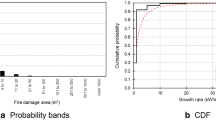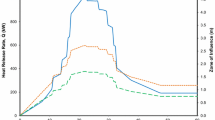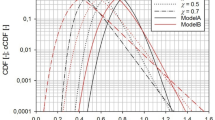Abstract
Understanding and quantifying property loss fire risk is critical to enabling decision makers in the fire field to make informed decisions. For example, the impact of various decisions made by fire departments on the fire risk in their community, while qualitatively understood by most parties, is not well quantified. Lack of quantification can lead to misdiagnosis and miscommunication on the value of services that result in sub-par resource allocations that negatively impact constituencies. Additionally, the confounding effects between fire department performance and fire risk in publicly available fire data can cause standard regression models to supply counter-intuitive conclusions based upon valid correlations (due to certain critical variables that are difficult to collect and thus unobserved). A methodology is presented that utilizes United States housing, room layout, and fire incident data, as well as experimental heat release rates, material degradation rates, and thermophysical property data in conjunction with physical fire models to estimate a community-averaged extent of fire damage in homes. Housing layout data for single family residential homes were collected from the American Housing Survey. Five home categories representing 45% of U.S. homes were selected for analysis. The U.S. Fire Administration National Fire Incident Reporting System database was used to select the distribution of initial fuels and ignition locations. Survey data was taken to specify furniture layout within the homes. A total of 5167 scenarios were developed for the combinations of home geometry, first item ignited, and furniture layout. Fire evolution was predicted for these scenarios using CFAST and coupled to a pyrolysis-inspired damage model using heat flux to targets in the homes. A damage evolution probability function was constructed for the ensemble of home and furnishing layouts and ignition distributions. This damage model was exercised in a decision analysis problem to demonstrate the utility of the methodology for community-scale resource allocation. Sensitivity studies on the model are likewise performed, indicating the largest source of uncertainty to be linked to the choice of surrogate material properties when calculating home damage. Comparison to best available data is made to assess the robustness of the model.















Similar content being viewed by others
References
National Commission on Fire Prevention and Control (1973) America Burning. US Government Printing Office, WASHINGTON, DC
Upadhyay RP (2008) Treatment of design fire uncertainty using quadrature method of moments. Fire Saf J 43(2):127–139
Hostikka S, Korhonen T, Keski-Rahkonen O (2005) Two-model monte carlo simulation of fire scenarios. Fire Saf Sci 8:1241–1252
Hostikka S, Keski-Rahkonen O (2003) Probabilistic simulation of fire scenarios. Nucl Eng Des 224(3):301–311
Fraser-Mitchell JN (1994) An object-oriented simulation (crisp 11) for fire risk assessment. Fire Saf Sci 4:793–804
Arshi SS, Nematollahi, M, Sepanloo K (2010) Coupling CFAST fire modeling and SAPHIRE probabilistic assessment software for internal fire safety evaluation of a typical TRIGA research reactor. Reliab Eng Syst Saf 95(3):166–172
Clarke FB, Bukowski RW, Stiefel SW, Hall JR, Steele SA (1990) The national fire risk assessment research project final report. NFPA, Quincy, MA
Hall JR, Sekizawa A (1991) Fire risk analysis: general conceptual framework for describing models. Fire Technol 27(1):33–53
Newman JS, Yee GC, Su P (2016) Smoke characterization and damage potentials. In: Hurley MJ (ed) SFPE handbook of fire protection engineering, 5th edn. Springer, New York, NY, pp 724–744
American Housing Survey (2013) Ahs 2013 national public use file (puf). U.S. Census Bureau. http://www2.census.gov/programs-surveys/ahs/2013/AHS%202013%20National%20PUF%20v1.2%20CSV.zip. Accessed 19 Sept 2016
U.S. Fire Administration (2012) National Fire Incident Reporting System (NFIRS). https://www.usfa.fema.gov/downloads/pdf/nfirs/NFIRS_Complete_Reference_Guide_2015.pdf
U.S. Fire Administration National Fire Data Center (2013) National fire incident reporting system complete reference guide. U.S. FEMA, Washington, DC
Greene MA, Andres C (2009) 2004–2005 national sample survey of unreported residential fires. U.S. CPSC, Bethesda, MD
American Factfinder/American Community Housing Survey 5 year estimates (2014) Dp-04: Selected housing characteristics. U.S. Census Bureau. www.factfinder.census.gov Accessed 18 Aug 2016
U.S. Fire Administration/National Fire Data Center (2013) National fire incident reporting system complete reference guide. FEMA, Washington, DC
Anderson A, Janssens M (2015) A multi-national survey of low-energy and smoking materials ignition fires. Fire Technol. https://doi.org/10.1007/s10694-015-0550-6
Panero J, Repetto N (1975) Anatomy for interior designers, 3rd edn. Whitney Library of Design, New York, NY
Merrell P, Schkufza E, Li Z, Agrawala M, Koltun V (2011) Interactive furniture layout using interior design guidelines. ACM Trans Graph 30(4):87
Probuilder (2016) 2016 housing giants rankings. http://www.probuilder.com/2016-housing-giants-rankings. Accessed 19 Oct 2016
Baker G, Fleury R, Spearpoint M, Fleischmann CM, Wade C (2011) Ignition of secondary objects in a design fire simulation. Fire Saf Sci 10:1359–1372. https://doi.org/10.3801/IAFSS.FSS.10-1359
Modak AT (1977) Thermal radiation from pool fires. Combust Flame 29:177–192
Reams R (1999) Hadamard inverses, square roots and products of almost semidefinite matrices. Linear Algebra Appl 288:35–43
Moritz AR, Henriques FC (1947) Studies of thermal injury: Ii. the relative importance of time and surface temperature in the causation of cutaneous burns. Am J Pathol 23(5):695
Henriques FC (1947) Studies of thermal injury v; the predictability and the significance of thermally induced rate processes leading to irreversible epidermal injury. Arch Pathol 43(5):489–502
Stoll AM, Greene LC (1959) Relationship between pain and tissue damage due to thermal radiation. J Appl Physiol 14(3):373–382
Incropera FP, DeWitt DP, Bergman TL, Lavine AS (2007) Fundamentals of heat and mass transfer, 6th edn. Wiley, New York, NY
Li X, Zhang X, Hadjisophocleous G, McGregor C (2015) Experimental study of combustible and non-combustible construction in a natural fire. Fire Technol 51(6):1447–1474
Kerber S (2012) Analysis of changing residential fire dynamics and its implications on firefighter operational timeframes. Fire Technol 48(4):865–891
Sundström B (1993) CBUF: Fire safety of upholstered furniture—the final report on the cbuf research programme. Technical Report EUR 16477 EN, European Commission Measurements and Testing
Babrauskas V (2008) Heat release rates. In: DiNenno PJ (ed) SFPE handbook of fire protection engineering, 4th edn. National Fire Protection Association, pp 3-1–3-59
Ohlemiller TJ, Gann RG (2002) Estimating reduced fire risk resulting from an improved mattress flammability standard. NIST TN 1446, NIST
Cleary TG (1992) Flammability characterization with the lift apparatus and the cone calorimeter. In: Technical and marketing issues impacting the fire safety of building and construction and home furnishings applications. Fire Retardant Chemicals Association
Harper CA (ed) (2004) Handbook of building materials for fire protection. McGraw-Hill, New York, NY
Babrauskas V (2002) Ignition of wood: a review of the state of the art. J Fire Prot Eng 12(3):163–189
Boult MA, Gamadia RK, Napier DH (1972) Thermal degradation of polyurethane foams. In: I. Chem. E. symposium series, No. 33. Instn chem. Engrs, London
Agrawal RK (1985) On the use of the arrhenius equation to describe cellulose and wood pyrolysis. Thermochim Acta 91:343–349
Al-Salem SM, Lettieri P (2010) Kinetics of polyethylene terephthalate (pet) and polystyrene (ps) dynamic pyrolysis. World Acad Sci Eng Technol 66:1267–1275
US Nuclear Regulatory Commission (2005) EPRI/NRC-RES fire PRA methodology for nuclear power facilities. Volume 2: detailed methodology. NUREG/ CR-6850, Washington, DC
City of Austin (2015) Fire. In: 2015–2016 Austin, Texas approved budget volume one, pp 423–445. https://assets.austintexas.gov/budget/15-16/downloads/Vol1Approved_Final.pdf
Averill JD, Moore-Merrell L, Barowy A, Santos R, Peacock R, Notarianni KA, Wissoker D (2010) Report on residential fireground field experiments. TN 1661, NIST
Zalok E, Eduful J (2013) Assessment of fuel load survey methodologies and its impact on fire load data. Fire Saf J 62: 299–310
Khattab MA, El-Ashael AA, Kandil SH (1999) Effect of contamination of cotton fabric with linseed oil on the activation energies of pyrolysis and oxidation of the fabric. Fire Mater 23(3):131–137
Gelman A, Carlin JB, Stern HS, Dunson DB, Vehtari A, Rubin DB (2013) Bayesian data analysis, 3rd edn. CRC Press, Cambridge, MA
U.S. Fire Administration National Fire Data Center (2011) National fire incident reporting system version 5.0 fire data analysis guidelines and issues. U.S. FEMA, Washington, DC
National Fire Protection Association et al (2010) NFPA 1710, standard for the organization and deployment of fire suppression operations, emergency medical operations, and special operations to the public by career fire departments. NFPA, Quincy, MA
Holborn PG, Nolan PF, Golt J (2004) An analysis of fire sizes, fire growth rates and times between events using data from fire investigations. Fire Saf J 39(6):481–524
Lennar Corp. (2016) Mashpee new home plan. http://www.lennar.com/new-homes/florida/orlando/championsgate/championsgate/country-club-ii-at-championsgate/mashpee. Accessed 19 Oct 2016
Lennar Corp. (2016) Orleans new home plan. http://www.lennar.com/new-homes/florida/orlando/championsgate/championsgate/country-club-ii-at-championsgate/orleans. Accessed 19 Oct 2016
Lennar Corp. (2016) Genova new home plan. http://www.lennar.com/new-homes/florida/miami/miami/artesa/villas/genova. Accessed 19 Oct 2016
Lennar Corp. (2016) Rosemary new home plan. http://www.lennar.com/new-homes/florida/miami/homestead/vineyards/sonoma-presidential/beringer. Accessed 19 Oct 2016
Lennar Corp. (2016) Sunflower new home plan. http://www.lennar.com/new-homes/texas/houston/baytown/bay-river-colony/brookstone-and-wildflower-collections/sunflower. Accessed 19 Oct 2016
Lennar Corp. (2016) Raleigh new home plan. http://www.lennar.com/new-homes/florida/orlando/winter-garden/independence/independence-manors-phase-iii/raleigh. Accessed 19 Oct 2016
Lennar Corp. (2016) Honeysuckle new home plan. http://www.lennar.com/new-homes/texas/houston/baytown/bay-river-colony/brookstone-and-wildflower-collections/honeysuckle. Accessed 19 Oct 2016
Lennar Corp. (2016) Rosemary new home plan. http://www.lennar.com/new-homes/texas/houston/conroe/cedar-woods/brookstone-and-fairfield-collections/rosemary. Accessed 19 Oct 2016
Lennar Corp. (2016) Mimosa new home plan. http://www.lennar.com/new-homes/texas/houston/crosby/newport-seven-oaks/stone-twin-villas/mimosa. Accessed 30 March 2016
Lennar Corp. (2016) Travertine new home plan. http://www.lennar.com/new-homes/texas/houston/baytown/bay-river-colony/brookstone-and-wildflower-collections/travertine. Accessed 19 Oct 2016
Acknowledgements
This work was funded by the Federal Emergency Management Agency’s Assistance to Fire-Fighters Grant Program, Grant Number AFG-EMW-2015-FP-00312. The authors would like to thank Lori Moore-Merrell of IAFF, Tyler Garner of Prominent Edge, Craig Weinschenk of UL and Tyler Buffington for their contributions to this work.
Author information
Authors and Affiliations
Corresponding author
Rights and permissions
About this article
Cite this article
Anderson, A., Ezekoye, O.A. Quantifying Generalized Residential Fire Risk Using Ensemble Fire Models with Survey and Physical Data. Fire Technol 54, 715–747 (2018). https://doi.org/10.1007/s10694-018-0709-z
Received:
Accepted:
Published:
Issue Date:
DOI: https://doi.org/10.1007/s10694-018-0709-z




